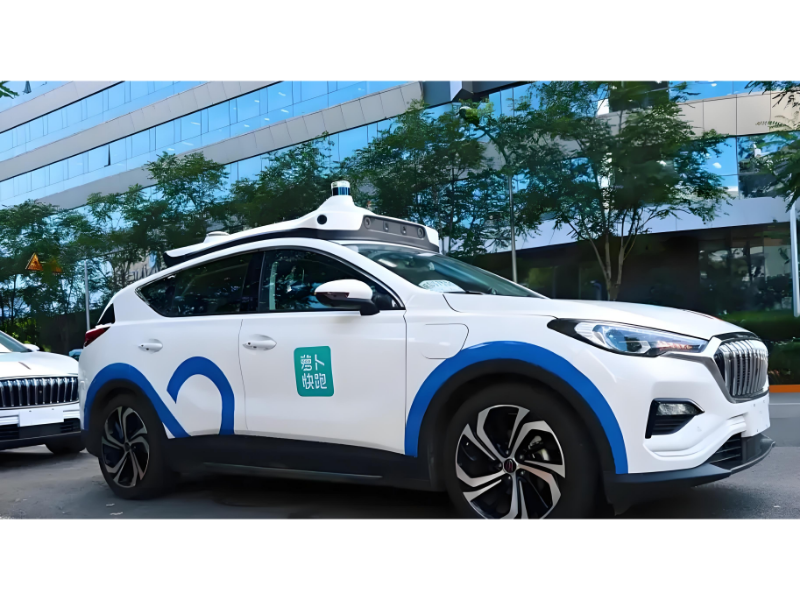- Autonomous driving technology advances rapidly.
- Robo-taxi service ‘Luobo Kuaipao’ emerges as a key player.
The idea of self-driving cars has always seemed like a far-off, futuristic concept. But in recent years, companies around the world have been racing to turn that dream into reality. Among them, Baidu‘s ‘Luobo Kuaipao‘ has taken significant strides, especially in the bustling cityscapes of China.
My experience with ‘Luobo Kuaipao’
During my recent trip to Beijing for the China Internet Conference, I had a thought-provoking conversation with a taxi driver on my way to the train station. We delved into the topic of autonomous driving technology and its potential impact. The driver, while navigating through the bustling streets, shared his concerns about the rapid advancement of technology.
Also read: ‘Awe and apprehension’ as China Internet Conference 2024 opens in Beijing
“Technology should serve people,” he remarked, “but the push for autonomous vehicles might take away our jobs, leaving us unemployed.” His insights highlighted the broader societal implications of automation in transportation.
We also discussed the practical challenges these vehicles might face in everyday scenarios. “In China, cutting in line is common,” he pointed out. “An autonomous car will always maintain a safe distance, but drivers with less patience and awareness might disrupt traffic flow.” His observations raised valid concerns about the compatibility of autonomous systems with current driving behaviors.
Reflecting on our conversation, I couldn’t help but think about the balance between technological innovation and its impact on livelihoods. While ‘Luobo Kuaipao’ represents progress towards safer and more efficient transportation, it’s crucial to consider how it integrates into the existing fabric of urban life.

Technology driving ‘Luobo Kuaipao’
Baidu’s ‘Luobo Kuaipao’ relies on a combination of advanced technologies, including Lidar, Radar, GPS, and sophisticated algorithms to interpret data and make driving decisions. These cars are equipped with an array of cameras and sensors that create a detailed map of the surrounding environment, allowing them to navigate even the most complex traffic scenarios.

According to a report by the China Daily, Baidu’s autonomous vehicles have driven over one million miles in urban environments, showcasing their reliability and safety. Moreover, the company has been working closely with regulatory bodies to ensure these vehicles meet stringent safety standards.
The Robocar is different from the car that everyone has ever imagined. It will be more like a robot, following the trend that cars will evolve in the future.
Robin Li, co-founder and CEO of Baidu, at the Baidu World Conference
Currently, ‘Luobo Kuaipao’ is operational in several major Chinese cities, including Beijing, Shanghai, Wuhan, and Guangzhou. In these cities, the service has integrated seamlessly with the existing transportation infrastructure, providing a glimpse into the future of urban mobility. Users can hail a ‘Luobo Kuaipao’ vehicle via a smartphone app, similar to traditional ride-hailing services, but with the added novelty of having no human driver behind the wheel.

In Beijing, ‘Luobo Kuaipao’ has been particularly well-received in the Yizhuang district, an area known for its technological innovation and high-tech industries. Here, the autonomous vehicles navigate complex traffic conditions, interact with traditional vehicles, and demonstrate their ability to handle real-world driving challenges.
Wuhan, with its rapidly growing infrastructure and strategic location as a central transportation hub in China, has become an important testing ground for ‘Luobo Kuaipao’. The city has been embracing smart city initiatives, and the introduction of ‘Luobo Kuaipao’ aligns perfectly with its vision of integrating advanced technology into daily life. The vehicles are being tested on a variety of routes, from busy city centres to quieter suburban roads. This diverse range of testing environments allows Baidu to gather valuable data and continually improve the system’s performance and reliability.
Enterprises have the responsibility to inform consumers that autonomous driving has not yet replaced human driving, and the driver must be able to take over control of the vehicle at any time.
Cui Dongshu, secretary-general of the China Passenger Car Association
The feedback from users has been overwhelmingly positive, with many praising the convenience and efficiency of the service. As ‘Luobo Kuaipao’ continues to expand and refine its services, Baidu is also exploring partnerships with other cities and companies to further enhance the capabilities and reach of its autonomous vehicles. The ultimate goal is to create a network of smart, interconnected cities where autonomous vehicles play a central role in public transportation, reducing traffic congestion and promoting sustainable urban living.
Pop quiz:
What is one of the primary technologies used in ‘Luobo Kuaipao’ to navigate roads?
A. Lidar
B. Radar
C. GPS
D. Infrared sensors
The correct answer is at the bottom of the article.
Real-world impact: Autonomous driving in action
In cities like Beijing and Shanghai, ‘Luobo Kuaipao’ has already started offering robo-taxi services to the public. Passengers can hail these taxis through a smartphone app, just like traditional ride-hailing services. Feedback from users has been overwhelmingly positive, with many praising the convenience and efficiency of the service.
For instance, my high school friend recently returned from studying in the UK and noticed the rapid development of autonomous driving in Wuhan. She posted on her WeChat Moments about her ride in ‘Luobo Kuaipao’, marvelling at how quickly technology had progressed. In a private chat, she mentioned that ‘Luobo Kuaipao’ is incredibly cheap, costing just a few yuan (less than a dollar) for a three to five-kilometre ride. However, she noted that the cars currently drive quite slowly, likely due to speed regulations still being fine-tuned. Despite this, she uses them frequently to navigate Wuhan’s Third Ring Road.
Recent incidents and responses
Recently, several media outlets reported an incident involving a ‘Luobo Kuaipao’ autonomous taxi in Wuhan on July 7. A video posted by a Wuhan resident on a short video platform showed a ‘Luobo Kuaipao’ vehicle colliding with a pedestrian. The video depicted a pedestrian lying in front of the taxi with police officers at the scene, causing partial vehicle congestion.

On July 8, a Baidu spokesperson responded to the incident, stating, “The accident occurred at the intersection of Yingwu Avenue and Guobo Avenue in Hanyang District, Wuhan, when the vehicle had a minor collision with a jaywalking pedestrian as it started moving at a green light. We immediately cooperated with the police and accompanied the pedestrian to the hospital for examination, where they are currently under further observation and rest.”
Ji Xuehong, Director of the Automotive Industry Innovation Research Center at North China University of Technology, told reporters, “Regarding accidents caused by autonomous driving, current policies do not clearly define the responsibilities. The division of responsibilities varies between different levels of autonomous driving (L2-L4). For L4-level autonomous driving accidents, if there is no one in the car, the vehicle owner and manager are held accountable.”
In Wuhan, a security guard asked a taxi to move, but it was unresponsive. Upon approaching, the guard realised it was a driverless taxi from Baidu’s “Luobo Kuaipao” fleet. Recently, 300 of these autonomous taxis began commercial operations in Wuhan. Users can book rides via an app, and the vehicles are notably cheaper than traditional taxis. Despite some initial scepticism and challenges, such as navigating traffic in a city known for aggressive driving, the service is gaining popularity. This marks a significant step in the commercialisation of autonomous driving technology in China. The video below titled ‘Can you drive faster than Luobo Kuaipao?’ introduces the topic in depth.
Also read: Tesla approved for autonomous driving tests in Shanghai
Also read: Humanoid robot takes the wheel: A glimpse into autonomous driving
The road ahead: Challenges and potential
Despite the promising advancements, several challenges remain before autonomous vehicles can fully replace human drivers. Safety is a primary concern, as these vehicles must be able to handle all possible scenarios on the road. Moreover, there are regulatory hurdles and the need for public acceptance and trust in this technology.
In terms of cost, the development and deployment of these vehicles require significant investment. However, as technology advances and economies of scale come into play, the cost is expected to decrease, making autonomous driving more accessible to the general public.
Further information: Real-world examples
The success of ‘Luobo Kuaipao’ isn’t an isolated case. In the United States, companies like Waymo and Tesla are also making significant strides in autonomous driving technology. Waymo, for instance, has been offering a robo-taxi service in Phoenix, Arizona, for several years. Similarly, Tesla’s Full Self-Driving (FSD) feature is continually evolving, with more capabilities being added through software updates.
These examples demonstrate a growing global trend towards autonomous vehicles, driven by technological advancements and a shift in consumer preferences towards more efficient and convenient transportation options.
Personal concerns and societal impact
While the benefits of autonomous vehicles are undeniable, I have a significant concern that lingers in my mind. Although self-driving cars are automated and less prone to human error, significantly reducing the likelihood of accidents caused by human mistakes, what about the severity of those rare errors? If an autonomous vehicle’s system fails and makes an incorrect decision, the consequences could be catastrophic. What happens to the passengers inside when the car makes a judgment that doesn’t align with reality, leading to a potential crash?
This concern is not unfounded. Despite rigorous testing and safety protocols, no system is infallible. The possibility of a software glitch, sensor malfunction, or unforeseen scenario that the AI cannot handle remains a critical risk. The idea of being in a vehicle where no human is present to take over in an emergency is unsettling. It’s one thing to reduce the frequency of accidents, but quite another to ensure that when an accident does occur, the outcomes are not disproportionately severe.
Summary: A personal and emotional perspective
Riding in ‘Luobo Kuaipao’ wasn’t just a glimpse into the future—it was a poignant reminder of how far technology has come. The convenience, efficiency, and safety of these vehicles have the potential to transform our cities and the way we travel.
At the same time, I can’t ignore the taxi driver’s fears. The impact on jobs is a significant concern. As we embrace technological advancements, we must also consider the livelihoods of those whose jobs may become obsolete. Balancing innovation with empathy and foresight is crucial as we navigate this transformative journey.
The emotional and societal implications of autonomous driving are profound. As we move towards a future where ‘Luobo Kuaipao’ and similar technologies become commonplace, we must remember the human stories intertwined with this progress. It’s about more than just technology; it’s about how these advancements can coexist with our values, our communities, and our shared humanity.
The Correct answer is A. Lidar
